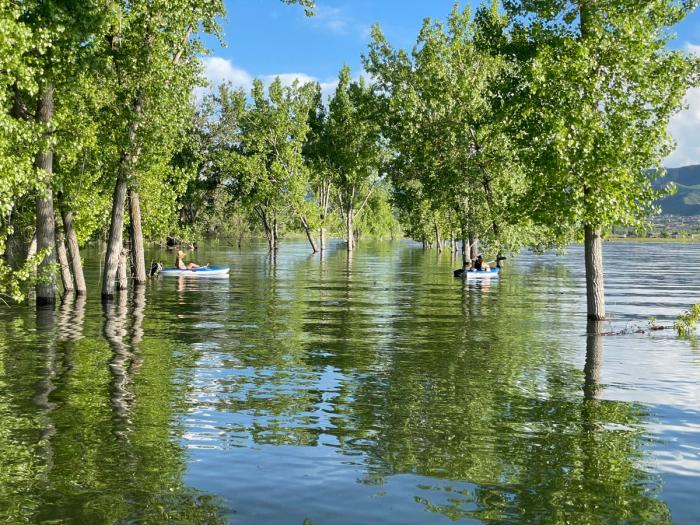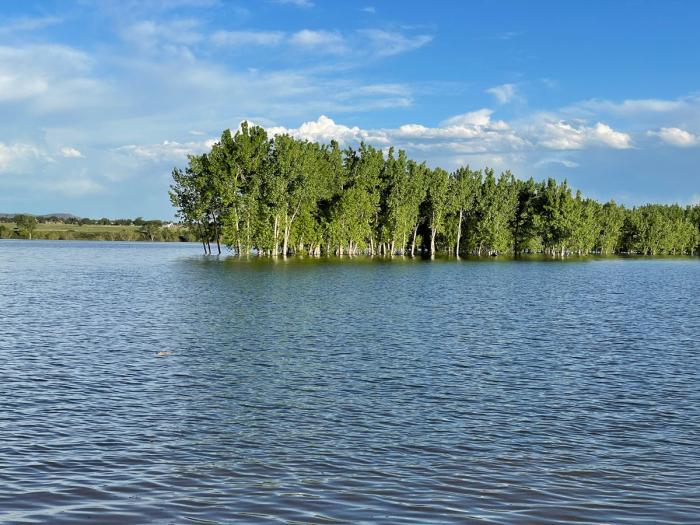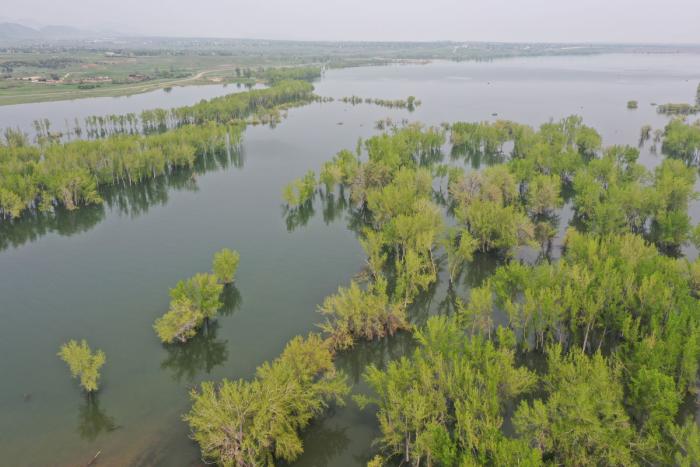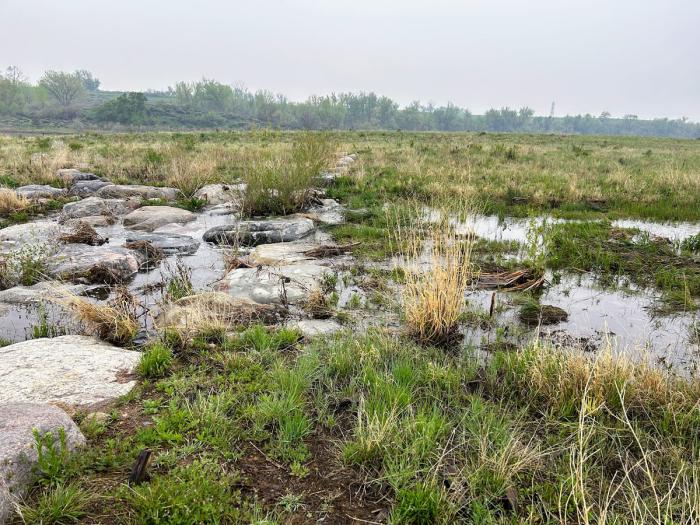Introducing: Your new, expanded Chatfield Reservoir
The south side of Chatfield Reservoir looks more like the Florida Everglades than a high-plains lake this spring.
The trunks of cottonwood trees disappear below the rippling water and the reservoir’s footprint has expanded onto once-dry ground.
The high water is great for kayakers and paddleboarders who can now float through the trees, but it’s also a welcome site for water supply and flood control along the South Platte River.
What does all this rain means to Colorado and Denver? We got answers, by the numbers.
Much like the water level in a bathtub rises as more water is added, the surface of the popular reservoir at Chatfield State Park in Littleton reached its new “full pool” mark of 5,444 feet above sea level May 19.
It’s the first time the reservoir has hit the milestone since the 2020 approval of the Chatfield Storage Reallocation Project that increased the amount of water the reservoir can safely hold.
The project allowed the U.S. Army Corps, which owns Chatfield Reservoir and Dam, to allocate an additional 20,600 acre-feet of water to be stored in the reservoir without jeopardizing the dam’s ability to manage floodwaters. That means the reservoir’s surface will be 12 feet higher at full operational capacity compared to its old storage capacity.
The extra 20,600 acre-feet translates to 6.7 billion gallons of water, roughly enough water to supply 82,400 households for an entire year.
Multiuse reservoir
Built after a disastrous flood on the South Platte River through the metro area in 1965 and in operation since 1975, Chatfield’s primary purpose is to hold back floodwater. But the reservoir also plays an important role in wildlife habitat, recreation, municipal water supply and irrigation water for farms.
Prior to 2020, Denver Water was the only entity allowed to store water in Chatfield. The utility uses the water for its customers and for exchanges with downstream water users.
The Chatfield Storage Reallocation Project allowed Denver Water to store more water in the reservoir — along with nine other agencies in Adams, Douglas, Jefferson, Park and Weld counties as well as the state of Colorado.
“For Denver Water, we always like to have full reservoirs because it provides water security and reliability for our customers,” said Russell Slade, a senior water planner at Denver Water.
“The additional water we can now store in Chatfield helps us today and in times of drought in the future.”
Big boost
During the mid-May deluge that soaked the metro area, Chatfield’s watershed got hit with more than 5 inches of rain May 10-13. As the rainwater flowed into the reservoir, its surface level rose by more than 9 feet between May 11-19 — when Chatfield hit its new “full” level.
With the completion of the reallocation project, instead of all that extra water going downstream and causing flooding along the South Platte River, the reservoir captured the high flows. Partners in the reallocation project will store the water for later use as municipal water supply, irrigation water and environmental uses.
“We found ourselves in the perfect situation to capture the high flows from the big storm,” said Charly Hoehn, project manager for the Chatfield Reservoir Mitigation Company, an organization created to oversee the additional water in the reservoir.
“The partners were able to get their water supply and the dam did its job of holding back floodwaters.”
Environmental benefits
Another objective of the reallocation project was to improve the habitat along the South Platte River by creating an “environmental pool” of water within the reservoir.
The pool of water can be used any time during the year for strategic releases into the South Platte River to enhance stream flows and improve water quality.
Colorado Parks and Wildlife will manage the environmental pool to help wildlife habitat and recreation as the South Platte River flows through the metro area.
Hoehn said the environmental pool was made possible through the generosity and hard work of 22 public and private organizations, foundations, nonprofits and individuals — including Denver Water.
The project also included additional environmental mitigation measures, such as riffle drop structures, side channels and sloughs along Plum Creek and the South Platte River above the reservoir.
“These features proved to be highly effective during the heavy rains and minimized the adverse effects of erosion during the high flows,” Hoehn said.
Creative collaboration
The concept for the Chatfield Storage Reallocation Project began in the 1980s as a way to find additional water storage for the growing Front Range population using an existing dam.
“This project is a great example of how local, state and federal partners can all work together to find creative solutions to Colorado’s water issues,” Hoehn said. “All of our partners, ranging from agriculture communities to municipalities to recreators and environmental enthusiasts, have something to celebrate."
What’s next?
As for the future of Chatfield, Hoehn said water levels will be different each year and fluctuate throughout the summer. Water levels are dependent on mountain snowpack, rain and water demand.
The surface elevation of 5,444 feet seen in the spring of 2023 is what a “full pool” looks like and would most typically be reached in the spring — when conditions permit.
The level could go higher in the event of a large rainstorm, when Chatfield would be used to store floodwaters. As with most reservoirs in Colorado, the reservoir level will likely go down over the summer months as water is used for municipal and agricultural uses.
Denver Water works with Colorado Parks and Wildlife to maintain a water level at Chatfield of at least 5,426 feet from Memorial Day to Labor Day, unless the utility has to impose watering restrictions due to drought conditions.
“This project has been years in the making and all of the partners are happy to see the reservoir reach its new height,” said Jeff Bandy, water planning manager at Denver Water.
“We’re excited that Chatfield can continue to serve its many duties and be a great benefit to our community for years to come.”
More information about the project and a list of frequently asked questions can be found on the Chatfield Reservoir Mitigation Company website.
Check out this story from 9News to see an interview with Charly Hoehn about the high water at Chatfield.





